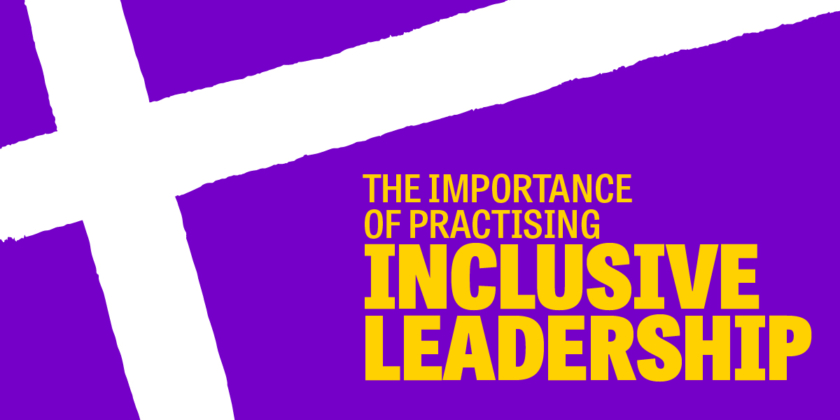What Inclusive Leadership does, how it benefits organisations, and how to foster thriving leadership within your business
The business world is constantly discovering new ways in which the pandemic has impacted the world of work, whether that’s in a positive or negative way. After adapting to the remote and hybrid realities, organisations had to cope with the Great Resignation and a global skills shortage, as well as shifting product offerings to fit changing customer demands.
Leadership teams had to shift gears, think of new strategies, keep morale up, and generally hold down the fort over some extremely difficult years, and leaders everywhere are feeling the strain. They are experiencing burnout, stress, and an increasing sense of disconnection from their teams, to the point where many of them are currently thinking of jumping ship. In fact, research shows that leaders’ intention to leave their organisation is the number one employee trend in 2022.
Considering that leaders today are expected to look after staff and their wellbeing, the organisation’s profit margins, the community in which they operate, as well as the planet as a whole, this is hardly surprising.
It’s true that employees and members of the community are now expecting a different kind of leadership, one that focuses on their people’s welfare as much as it does on revenue, now and for the future, and some leaders are struggling to adapt. Research shows that “(…) only 11% of organisations report having a strong or very strong leadership bench.” We’re reaching a tipping point as both leaders and employers are burned out from a workplace culture that doesn’t support, sustain, or restore their wellbeing.
So, what can HR departments do to improve the situation? Where should they focus their efforts? At Let’s Talk Talent (LTT), we believe that a drastic shift in leadership style is required, and that Inclusive Leadership is the only way to go.
What is inclusive leadership? Is it the same as empathetic leadership?
It’s important to differentiate Inclusive Leadership from Equality, Diversity, and Inclusion (ED&I). At LTT, we believe organisations need to take a step further and move beyond ED&I to reach a sense of belonging. “Diversity is inviting everyone to the party,” says Jo, MD at LTT. “Inclusivity is getting them to dance.”
So, what is inclusive leadership? It is about adopting a human-centric approach to leadership; one that focuses on belonging and psychological safety within the organisation. Why psychological safety? Studies have repeatedly shown that teams that feel psychologically safe perform at a much higher level.
Role-modelling and encouraging trust and collaboration directly leads to innovation, as team members feel safe to think outside the box, try new things, make mistakes, and ultimately contribute to the kind of growth culture that is essential for business survival. But trust isn’t easy to gain, and it’s easy to lose. How can leadership teams foster trust and lay the foundations for a psychologically safe workplace?
We’ve previously established that leadership is an innate quality that cannot be learned (see our article on whether leaders are born or trained). Inclusive leaders go a step further. They place care at the centre of everything they do, and make conscious efforts to create the kind of connections with their team members, their communities, and themselves that allow them to grow, feel motivated, and in turn energise their people.
How can leaders become inclusive leaders?
As mentioned, Inclusive Leadership is all about caring. Whilst this may seem like a vague concept, it can actually be broken down into four key pillars, to be used as guiding principles for those who wish to adopt a more empathetic leadership style and see their workforce thrive. “The four pillars are a bit like a guiding light. It’s there to show you the way, but you never fully reach it. You just keep heading in the right direction,” says Stefano Battaglia, Associate at LTT.
Pillar 1: Inclusive leaders help others find purpose
Leaders are part of this rare tribe of people that have the ability to combine purpose and passion (see our article on the difference between managers and leaders). They set a clear direction for the business and talk about it in a way that inspires others to get on board. However, it’s not just about helping the business reach its financial objectives. Great leaders help others find and understand their own purpose, so they can contribute to reaching organisational goals in a way that fulfils them and generates motivation, energy, and job satisfaction.
Pillar 2: Inclusive leaders have meaningful connections
Being a leader is not an easy task. But despite extremely busy diaries, inclusive leaders take time to get to know their people and build close relationships. This is crucial for job satisfaction, especially in today’s workplace where so many workers operate remotely. There is an increasing feeling of disconnection in the wake of the pandemic, with 65% of workers saying “(…) they feel less connected to their coworkers.” Leaders have a role to play in creating opportunities for connections, which benefits both their employees and themselves.
Pillar 3: Inclusive leaders generate energy
We’ve mentioned this a few times, but generating energy and motivation is an intrinsic leadership trait. Leaders have the ability to sustain their own – and their team’s – energy levels, especially during difficult periods. However, like everyone else, they are humans, and keeping energy and motivation up at all times is not possible. Inclusive leaders are self-aware and know when their reserves of physical, emotional, mental, spiritual, or social energy are running low. They have ways to identify what needs adjusting, as well as established coping mechanisms that allow them to bounce back quickly and face new challenges head on.
Pillar 4: Inclusive leaders have balance
Inclusive leaders understand themselves. They know their strengths and their challenges, and develop strategies to both optimise the former and work on the latter. Balance also involves social sensitivity, which means clearly evaluating a situation to then choose the most effective and sensible response to it. To do so, they regularly seek 360 feedback and gain awareness through reflection and observation, and use practical tools such as psychometric testing. This requires a conscious effort, as well as some dedicated time to pause and reflect. It also involves the willingness to stretch their behavioural range and take risks by choosing an approach that may not feel quite as natural to them as their default response may do.
Conclusion
We all know the pandemic has led to people re-evaluating their priorities and placing their focus on what is important to them, be it a better work-life balance, a more positive work culture, or a career that supports their personal goals. Organisations cannot simply revert back to pre–COVID leadership styles, as the expectations we have of our work leaders have shifted, and employees, investors, and the wider community expect more from leadership teams.
However, leaders are humans, and currently, many of them are burned out, stressed, or thinking of leaving. Adopting an inclusive style that restores motivation and energy levels as well as allow them to focus on their own wellbeing is the only way to go.
Inclusive leadership puts care at its core, and ensures your C-suite has enough energy left in the tank to take care of themselves and feel rejuvenated after some fairly turbulent years, so they can continue to benefit the organisation in a positive way for years to come.
If you’d like to know more about how to foster inclusive leadership within your organisation, give us a call. Or have a look at our Inclusive Leadership Series of resources.

